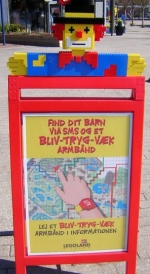Bluesoft, a maker of Wi-Fi-based wireless security and location RFID technology, has announced the deployment of its AeroScout system within Legoland Denmark, one of Europe’s largest amusement parks. Legoland Denmark attracts around 1.6 million visitors annually, and each season, the theme park’s staff is called upon to help locate approximately 1,600 children that have become separated from their parents. The park’s operator says that the new system will help quickly reunite those children with their family.
According to Bluesoft, its technology was chosen only after the park examined and then rejected the use of more traditional RFID systems because of the far greater cost a traditional RFID system would require. “Legoland had looked at active RFID tagging, but they realized they could pinpoint a child’s location without deploying hundreds and hundreds of readers throughout the park,” says Andris Berzins, vice president of business development at Bluesoft, which is headquartered in San Mateo, Calif.
Bluesoft’s active tags operate using 802.11b wireless LAN technology. That, the company maintains, means that its tags can be tracked over far wider areas with far fewer readers compared with traditional active-tag RFID systems. In the Legoland deployment, those readers consisted of 38 Bluesoft AeroScout location receiver units that can read an AeroScout tag’s 2.4 GHz signal as well as any 802.11b-enabled device.
Another advantage of using 802.11: Bluesoft’s system can use preexisting Wi-Fi infrastructure, which means that AeroScout location receivers can be connected to the same cabling used for Wi-Fi access points.
“Legoland had already decided to deploy a wireless LAN for point-of-sale equipment and other operational functions across the park, and ours was another application they could use that investment for,” says Berzins.
According to Bluesoft, Legoland represents the world’s largest deployed Wi-Fi location network: 2.5 million square feet. The network not only provides a way to quickly connect parents with missing children but also a new revenue stream for the park.
Parents can pay 3 euros for a day’s rental of a tag for their child. Legoland attaches the Bluesoft AeroScout T2 tag, about 1.5 inches by 2.5 inches, to the child’s wrist by means of a disposable wristband. That tag is then registered to the parents’ mobile phone number.
The park will be able to constantly track that tag anywhere in the park. The Bluesoft AeroScout system uses a minimum of three location receivers and Bluesoft’s own AeroScout software to triangulate a tag’s position by recording the time of arrival of a single tag transmission at several receivers and using time difference of arrival (TDOA) algorithms to determine location. Parents wanting to locate their child will send a text message from their mobile phone and receive an automated response telling them the location, within 10 feet, of their child. The process takes between 10 and 20 seconds, according to Bluesoft.
Toward the end of Legoland’s summer season last year, the service was tested in a small section of the park for a few weeks. After the park closed for the season, the AeroScout system was installed throughout the park over a period of several months and was ready when the facility reopened in late March.
So far, Legoland Denmark has purchased 500 tags, which have a list price of $85 each, and the park has plans to buy thousands more, perhaps as early as the end of this year, according to Bluesoft. The receivers, which are protected within a weatherproof enclosure, cost between $3,000 to 4,000 each.
KidSpotter, a theme park application developer based in Aarhus, Denmark, provided software to link the AeroScout system with mobile phone networks and also provided software that can enable the park to analyze tag location data to help optimize the distribution of visitors within the park in real time.


